Digital Wellness Appears to Have Joined Our Lexicon
A recent study shows social media may be more addictive than cigarettes or alcohol.

The University of Washington has developed an excellent Digital Wellness 101 for young Huskies. It discusses the impact of social media and a person’s mood including the fact social media may be more addictive than cigarettes or alcohol. The Express Tribune supported that statement in a May 2017 article expounding a Royal Society for Public Health UK Study conducted among 16-24 year olds. According to the study Instagram was considered to have the most negative impact on young people’s mental health. Concerns about body image, lack of sleep, and bullying were all listed as issues exacerbated by the social media tools.
Common Sense Media provides materials for parents to help develop Kid’s Digital Well-Being. There are online courses as well to help up learn how to balance digital and the offline world. Google has set up a Digital Wellbeing website with the opening line, “Great technology should improve life, not district from it.” Companies such as Space are holding retreats on “Phone/Life Balance.” The Open University provides a free course on Digital Literacy which includes a module on Digital well-being. Maybe these are important concerns in an era when multiple sources have added new base levels to Maslow’s Hirearchy of needs, WiFi and battery life, as being more important than physical needs of food and shelter?
The St. Gregory the Great School in Cheltenham, UK, has a good example of a Digital Wellbeing site for students. The Madison Wisconsin Schools also have a digital wellness component to the materials they provide for staff to share with students.
It continues to be essential for educational technology leaders to help educators and parents ensure students are not only safe when in the digital world, but that they are able to balance between online and offline activities.
Steve Baule is an Educational Leadership Professor at the University of Wisconsin – Superior.
Tools and ideas to transform education. Sign up below.
